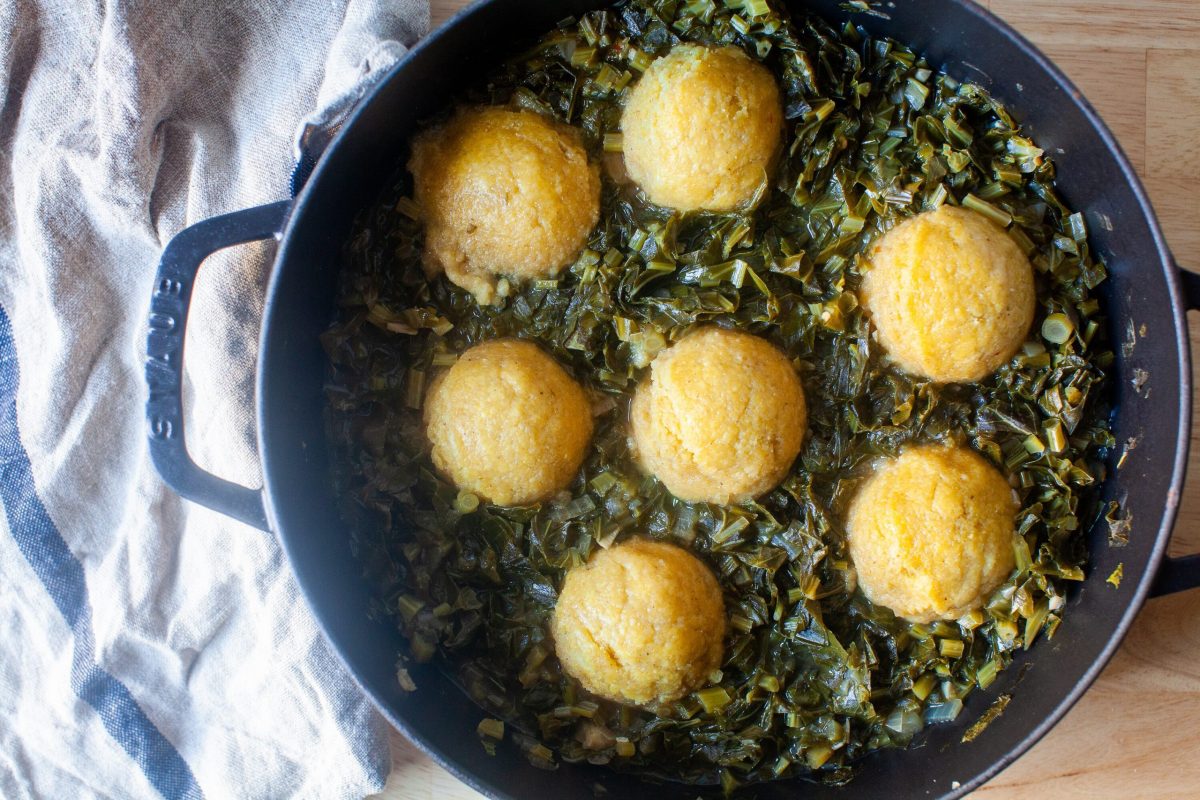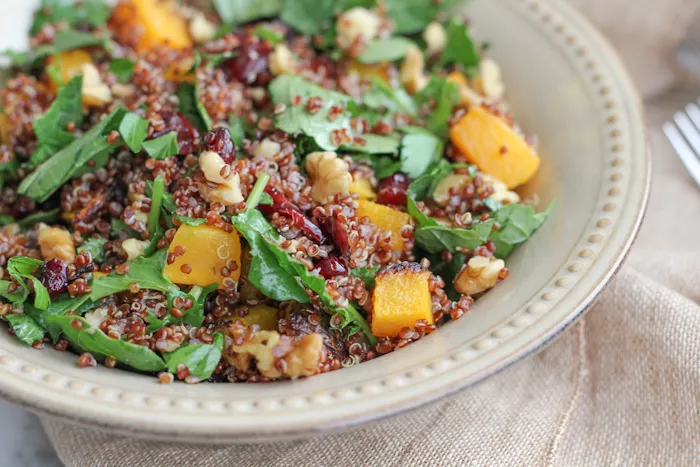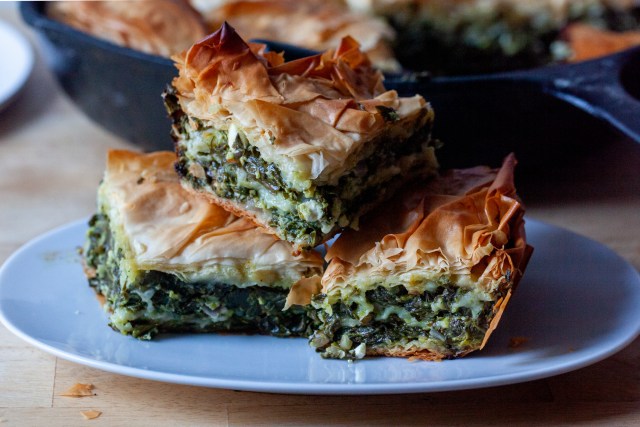Superfoods that are popular are often high in carbs, even if they are healthy and…

collard greens with cornmeal dumplings
One of my favorite cookbook purchases of the last year is Toni Tipton-Martin‘s Jubilee: Recipes from Two Centuries of African American Cooking. It’s one of those incredible books that even from the pages of the introduction quietly but irrevocably pivots some of the ways you think about food. Tipton-Martin talks about growing up in the Black Beverly Hills of Los Angeles, one of several communities in the U.S. that she says are rarely discussed in the media, “an omission of black middle and upper classes that serves to stereotype African Americans as poor, uneducated, and possibly dangerous.” Growing up, she had a diverse culinary upbringing, with her mother’s homegrown fruits and vegetables at the center, but she found that culinary heritage, and the larger story of the African American food that encompasses the middle class and well-to-do “was lost in a world that confined the black experience to poverty, survival, and soul food.” She found it frustrating. With this book, she hoped to tell a multifaceted story of African American food that includes, but also looks beyond, what people call Southern and soul.
And that’s just the introduction. For each recipe, headnotes explain the historical roots of the dish, cookbooks and literature that lend greater understanding, and the ways creative cooks are treating it today. While I’d already heard great things about the Baked (Barbecued) Beans, Peach-Buttermilk Ice Cream, Biscuits, Benne Wafers, I still found deciding what to cook first nearly impossible because Jerelle Guy’s magnificent photos make what is already delicious even more luxurious, until I remembered that my husband has been patiently requesting that I make collard greens for, oh, about all of almost-17 years we’ve been together. I’m one of the women she mentions in the intro that didn’t grow up eating a lot of greens, but I’ve come to like them as much as he does. Collards are, I’ve learned, spectacularly easy to grow, cook, and eat — they get sweet and almost silky after a long simmer. Traditional, Southern, soul, or country-style greens — Tipton-Martin calls them a “totemic soul food dish” — are often simmered for a long time, until quite tender, in a broth of ham hocks and other aromatics called potlikker, but she says they needn’t be cooked forever, just until they’re as tender as you like them, so this recipe provides a range. Choose the state of doneness that suits your taste and the greens you have.
Where I’ve been: It’s off-topic, it feels like oversight not to catch you up. I’d intended this recipe for the days leading up to July 4th, to go with the ribs, cornbread, baked beans, and conversations about what America is vs. what we would like it to be. But that weekend, the New York Times ran a piece they’d asked me to write about some thoughts I’d tweeted the week before about the binds that many of us are in as we head into a new school year. I’ve since been on Good Morning America, The Today Show, CNN, radio shows, and podcasts, on phone calls with teachers unions and childcare advocacy organizations and it’s been an honor to get to speak up for the people (kids, parents, teachers, essential workers) I think I are being hurt the most by a lack of funding and job protections, but it’s also been very surreal, not at all the July I was expecting to have (which involved more orzo salads, s’mores, socially distant sandwiches, and frozen drinks, naturally) but as it slows down, I’m excited to get back to talking about cooking, too.
Previously
Six months ago: Roasted Squash and Tofu with Ginger
One year ago: Corn Salad with Chile and Lime
Two years ago: Grilled Zucchini Ribbons with Pesto and White Beans
Three years ago: Grilled Pizza and Confetti Party Cake
Four years ago: Peaches and Cream Bunny Cake
Five years ago: Green Beans and Almond Pesto and Very Blueberry Scones
Six years ago: Sticky Sesame Chicken Wings and Brownie Ice Cream Sandwiches
Seven years ago: Slow-and-Low Dry Rub Oven Chicken and Grilled Bacon Salad with Arugula and Balsamic
Eight years ago: Blackberry Gin Fizz and Bacon Corn Hash
Nine years ago: Skirt Steak with Bloody Mary Tomato Salad and Flatbreads with Honey, Thyme, and Sea Salt
Ten years ago: Bread and Butter Pickles, Blue Cheese and Red Potato Tart, Zucchini and Ricotta Galette and Porch Swing
Eleven years ago: Mediterranean Pepper Salad, Cherry Brown Butter Bars and Watermelon Lemonade
Twelve years ago: Chopped Vegetables, Watermelon, and Feta Salad
Thirteen years ago: Rosanne Cash’s All-American Potato Salad and Ratatouille’s Ratatouille
Collard Greens with Cornmeal Dumplings
I was unable to get ham hock or smoked turkey wings the week I made these (in the more unevenly-stocked months of the pandemic) and decided to use bacon (8 ounces thick-cut in 2-inch segments) instead for the smoky flavor. The broth doesn’t have the depth of a broth made with bones, but the flavor was excellent.
- 2 smoked ham hocks or smoked turkey wings (see Note)
- 2 medium onions, quartered
- 4 celery stalks, including leaves, halved
- 2 carrots, trimmed and quartered
- 2 garlic cloves, peeled and smashed
- 1/2 teaspoon black peppercorns
- 2 bay leaves
- 1 1/2 quarts Smoky Soul Stock (above)
- 1/2 cup chopped onion
- 1 garlic clove, minced
- 1 pound collard greens
- 2 small dried red chile peppers or 1 teaspoon crushed red pepper flakes
- 3/4 teaspoon salt, plus more to taste (used 2t diamond in greens)
- Black pepper
- 1/2 cup all-purpose flour
- 1 1/2 cups coarsely ground cornmeal
- 1 teaspoon baking powder
- 1 teaspoon granulated sugar
- 2 tablespoons unsalted butter
- Salt, to taste
Smoky Soul Stock
Greens and dumplings
Make the Smoky Soul Stock: In a large heavy stockpot, bring 3 quarts water, the smoked meat, onions, celery, carrots, garlic, peppercorns, and bay leaves to a boil. Reduce the heat, and simmer, partially covered, until the flavors are well-blended, about 2 hours. The broth develops a stronger flavor the longer you let it simmer.
Remove the meat from the broth. When cool enough to handle, pull it off the bones (discard the skin, fat, and bones). Chop the meat and reserve for another use. Use a fine-mesh sieve to strain the stock. Refrigerate the stock until the fat floats to the top. Use a slotted spoon to skim off the fat and discard. Store the stock tightly covered in the freezer.
Make the Collard Greens with Cornmeal Dumplings: In a saucepan, bring the stock, onion, and garlic to a boil over high heat. Reduce the heat, cover, and simmer while preparing the greens.
Thoroughly wash the greens and trim away the stems, if desired. Discard the steps or chop small. Stack 2 or 3 leaves on a cutting board and roll tightly into a log. Slice the greens crosswise into 1/4-inch-wide ribbons. Place the greens and the chiles in the broth and return to a simmer. Cook, covered, for about 1 1/2 hours for very tender greens; you may cook them for less if you have young greens or prefer greens with more chew. Season to taste with salt and black pepper. Spoon out about 1 cup of the potlikker (the cooking broth) and set aside.
Meanwhile, in a small bowl, whisk together the flour, cornmeal, baking powder, sugar, and 3/4 teaspoon salt. In a small saucepan, melt the butter. Add the reserved potlikker, and heat to just below boiling. Remove the potlikker mixture from the heat and whisk half of it (1/2 cup) it into the dry ingredients, and more if needed, 1 tablespoon at a time (I needed almost the full cup to reach a thick batter consistency). Let stand 5 minutes. When cool enough to handle, use wet fingertips (or in my case, a big scoop) to shape the dough into 6 dumplings.
During the last 15 minutes of the collards’ cooking time, carefully drop the cornmeal dumplings into the pot with the greens, making sure the dumplings rest in the potlikker. Cover the pot and simmer until the dumplings are cooked through, 10 to 15 minutes.
Serve the greens and dumplings in bowls with plenty of potlikker.














